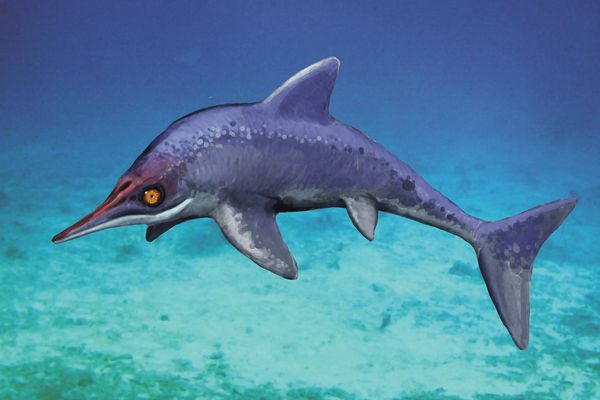New Sea Monster Found, Rewrites Evolution?
A new species of dinosaur-era sea reptile is rewriting the books on the evolution of so-called sea monsters, a new study claims.
The newfound—and potentially controversial—Malawania anachronus was a ten-foot (three-meter) long ichthyosaur, a group of dolphin-like creatures that could grow to 65 feet (20 meters) in length. These fast-swimming predators peaked in diversity during the Jurassic period.
Oddly, though, new fossil analyses suggest that M. anachronus roamed the oceans of the early Cretaceous period—66 million years after its closely related cousins were thought to live.
That's why Malawania anachronus—Kurdish and Greek for "out-of-time swimmer"—is "something that shouldn't be there, but it is," said study leader Valentin Fischer, a geologist and paleontologist at the Royal Belgian Institute of Natural Sciences.
"This 'living fossil' of its time demonstrates the existence of a lineage that we had never even imagined," Fischer said in a statement.
But Michael Caldwell, an ichthyosaur expert at the University of Alberta in Canada who was not involved in the study, cautioned against getting too excited about the find, citing the fact that the study is based on one incomplete specimen.
The new sea monster (pictured in an illustration) munched on fish in Cretaceous seas.
Tracing a "Living Fossil"
Petroleum geologists first uncovered a slab of rock containing a partial skeleton of an ichthyosaur in the 1950s in what's now the Kurdistan region of Iraq.
The slab was used as a stepping stone for mules until someone recognized its importance and sent it to the U.K. for analysis. Ichthyosaur expert Robert Appleby studied it until his death in 2004, without having solved the mystery of when the sea monster lived.
Enter Fischer and his team, who extracted microscopic spores and pollen from inside the slab of rock and dated them to the early Cretaceous, according to the study, published May 15 in the journal Biology Letters.
The team also took another look at the ichthyosaur family tree—adding the newest member to their analysis—and discovered that numerous ichthyosaur groups that appeared during the Triassic and Jurassic periods probably survived into the Cretaceous.
But several puzzles remain. For one, M. anachronus's body—especially its chest and forefins—looks very much like its early Jurassic relatives.
The scientists don't know how M. anachronus managed to keep the same body shape through the millennia—a "very rare feat" among marine reptiles, which tend to evolve quickly in response to changing ocean conditions.
Another mystery is why paleontologists haven't found this lineage before. One possibility is due to preservation issues: the Middle East hasn't yielded many complete ichthyosaur fossils, Fischer said.
That could be because there's not thorough fieldwork in the area, or because the sea monster lived in a confined and shallow seaway that may not have had as many animals as an open ocean.
Thin Evidence?
But the University of Alberta's Caldwell said that a new species rewriting evolution is "a hard argument to make with a single specimen," adding that other interpretations of evolution are made using hundreds of skeletons.
On top of that, the single specimen isn't ideal—it lacks the skull, a crucial element for determining ichthyosaur species.
Though the skull is important in identifying ichthyosaur species, several parts of the M. anachronus skeleton have "unique" and "peculiar" features that indicate it's a new species, noted study author Fischer.
Also challenging is that samples used to date M. anachronus came from a rock slab, and not the original site—it's easier to date the rock in which the fossil was found, Caldwell said. The microfossil data on M. anachronus is unspecific, giving a range of roughly six million years.
"I'm afraid it's a little bit thin ... when it comes to data," Caldwell said.
Nevertheless, paleontology means "trying to rewrite things from bits and pieces—we're lucky if we get anything out of the fossil record."
"I have to compliment them for giving it a whirl."(Christine Dell'Amore,National Geographic News,Published May 14, 2013)












